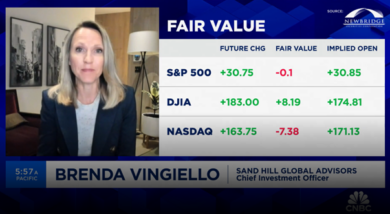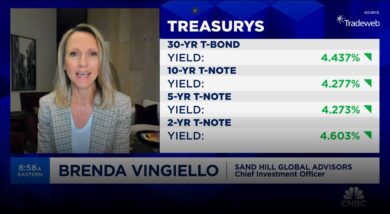Sand Hill's Chief Investment Officer, Brenda Vingiello, CFA, joins Jenny Harrington on “Halftime Report” to go over their most recent portfolio moves. Brenda's commentary begins
QE∞: Bernanke Crosses His Personal Rubicon
The greatest trick the devil ever pulled was convincing the world he didn’t exist.” – Keyser Söze, from the 1995 film “The Usual Suspects”
When censors first sat down and watched the movie Psycho, they deemed it to be too violent. In response, Hitchcock reviewed with them the violent scenes frame-by-frame. To their amazement, there was no violence shown, it was all implied. Just as the movie-going audience could imagine violence and horror at levels far beyond what actually existed, so now does investor psychology run amuck as it pertains to QE∞.
QE∞, or “infinite quantitative easing,” is Wall Street’s most recent contribution to the financial lexicon. It refers to the Federal Reserve’s latest strategy to boost the markets by turning their virtual printing presses on and buying bonds, in the hope of creating jobs. This is a policy derided by many economic purists, but celebrated by speculators and investors alike with the excitement of a Hitchcock psychological thriller.
The Federal Reserve, along with their European counterpart, is attempting to defy the course of history. Central banks, by suggesting an infinite printing press and using such words as “unlimited” and “open-ended” to describe their recently expanded efforts, hope to not only remove the risk of a bank or country failure, but to fire up economic growth in the face of this increasingly sluggish economic environment. History suggests this will prove to be a very difficult task.
The problem with implementing QE∞ is that the effective dose is unknown and each successive dosing has had a diminishing effect. Thus far, despite global central bank efforts to buy up government bonds around the world (the Federal Reserve alone, for instance, has purchased 77% of all Treasury issuance in 2012), their theory has failed to boost the lackluster employment market. By contrast, in the real world, the highly anticipated iPhone 5 is widely expected to boost the US economy by more than this latest round of unlimited QE.
Meanwhile, basic elementary fundamentals strongly suggest that when a central bank tries to prolong an exhausted economic cycle, inflation will eventually appear, with or without economic growth. There is a circular reason we can’t just print a million dollars for every man, woman and child, hand it to them and fix everything – and that reason is “too many dollars chasing too few goods” – or inflation.
That said, with economic growth slowing again, Bernanke has decided to go “all in” and take a leap of faith that the third time will be a charm. But unlike Caesar, whose irrevocable commitment to cross the Rubicon in 49BC led to victory, we think Bernanke may be just an academic general still fighting the last war. Why?
The first two rounds of quantitative easing fuelled a surge in commodities, both in energy prices and food costs. Several decades ago, central bank policy focus on creating “easy money” would generally drive up the price of stocks, but not commodities. Today, with the advent of new financial products (ETF’s), investors can gain access and readily trade commodities the way they trade stocks. The result is a much tighter relationship between stocks and commodities as prices now rise and fall in lock step like never before.
In effect, this means that energy and food prices act as interest rates used to, discouraging consumption even as the Federal Reserve believes it is stimulating the economy. We think Bernanke’s third attempt may end up being counterproductive, particularly as oil and food prices now have the potential to surge to levels that have acted as a tipping point for the global economy in the past. Perversely, ordering a full retreat from QE∞ would likely lead to a fall in oil and food prices and act as a significant tax cut for the middle class, thus stimulating the real economy.
While Sand Hill does not wish to underestimate a central bank’s ability to print money into infinity, we now believe we are entering a “payback” period for the excesses of the recent past. Specifically, this means we are entering a period of positive but lower economic growth, as well as a lower return environment as the economic cycle matures, monetary policy measures become less effective, and economic stimulus measures expire.
The reality is economies accumulate macroeconomic risks over long periods and along the way markets frequently anticipate crises prematurely and incorrectly. The stock market and the economy are “cousins not siblings” as the old Wall Street saw goes; they are not always closely linked in the here and now. Given the effect that QE∞ is having on the markets, and in recognition of the recently failed Facebook IPO, perhaps that historic relationship should now be described as “just friends.”
Despite the fact that the markets responded enthusiastically and much like Pavlovian dogs to this latest round of liquidity, Sand Hill is staying disciplined with its macroeconomic investment framework. This means that we are actually reducing the risk profile in your portfolio right now. It also means that in an environment where central banks want to deliberately create inflation to drive economic growth, portfolio positioning must account for such policies. Commodity exposure and inflation exposure in general will play an increasingly important role in portfolios going forward. As always, we are maneuvering to anticipate and adapt to an ever-changing environment.
It is said that art imitates life. History, psychology and philosophy play important interdisciplinary roles in the study of art – and of the capital markets. In that framework, QE∞ is perhaps best viewed as the latest painting to hang in the avant-garde wing of the increasingly antiquated “Museum of Keynesian Economic Theory.” Some people love it, others hate it. Our job as your advisor is to accept the economic reality of Bernanke’s latest work, and to remind ourselves that if the devil does exist, its name will ultimately be Inflation.
Articles and Commentary
Information provided in written articles are for informational purposes only and should not be considered investment advice. There is a risk of loss from investments in securities, including the risk of loss of principal. The information contained herein reflects Sand Hill Global Advisors' (“SHGA”) views as of the date of publication. Such views are subject to change at any time without notice due to changes in market or economic conditions and may not necessarily come to pass. SHGA does not provide tax or legal advice. To the extent that any material herein concerns tax or legal matters, such information is not intended to be solely relied upon nor used for the purpose of making tax and/or legal decisions without first seeking independent advice from a tax and/or legal professional. SHGA has obtained the information provided herein from various third party sources believed to be reliable but such information is not guaranteed. Certain links in this site connect to other websites maintained by third parties over whom SHGA has no control. SHGA makes no representations as to the accuracy or any other aspect of information contained in other Web Sites. Any forward looking statements or forecasts are based on assumptions and actual results are expected to vary from any such statements or forecasts. No reliance should be placed on any such statements or forecasts when making any investment decision. SHGA is not responsible for the consequences of any decisions or actions taken as a result of information provided in this presentation and does not warrant or guarantee the accuracy or completeness of this information. No part of this material may be (i) copied, photocopied, or duplicated in any form, by any means, or (ii) redistributed without the prior written consent of SHGA.
Video Presentations
All video presentations discuss certain investment products and/or securities and are being provided for informational purposes only, and should not be considered, and is not, investment, financial planning, tax or legal advice; nor is it a recommendation to buy or sell any securities. Investing in securities involves varying degrees of risk, and there can be no assurance that any specific investment will be profitable or suitable for a particular client’s financial situation or risk tolerance. Past performance is not a guarantee of future returns. Individual performance results will vary. The opinions expressed in the video reflect Sand Hill Global Advisor’s (“SHGA”) or Brenda Vingiello’s (as applicable) views as of the date of the video. Such views are subject to change at any point without notice. Any comments, opinions, or recommendations made by any host or other guest not affiliated with SHGA in this video do not necessarily reflect the views of SHGA, and non-SHGA persons appearing in this video do not fall under the supervisory purview of SHGA. You should not treat any opinion expressed by SHGA or Ms. Vingiello as a specific inducement to make a particular investment or follow a particular strategy, but only as an expression of general opinion. Nothing presented herein is or is intended to constitute investment advice, and no investment decision should be made based solely on any information provided on this video. There is a risk of loss from an investment in securities, including the risk of loss of principal. Neither SHGA nor Ms. Vingiello guarantees any specific outcome or profit. Any forward-looking statements or forecasts contained in the video are based on assumptions and actual results may vary from any such statements or forecasts. SHGA or one of its employees may have a position in the securities discussed and may purchase or sell such securities from time to time. Some of the information in this video has been obtained from third party sources. While SHGA believes such third-party information is reliable, SHGA does not guarantee its accuracy, timeliness or completeness. SHGA encourages you to consult with a professional financial advisor prior to making any investment decision.
Other Posts By This Author
- – A New Year’s Toast to the Silicon Valley Entrepreneur
- – How I Learned to Love the Bot
- – Thank You for Your Partnership
- – The Coming Deglobalization
Related Posts







